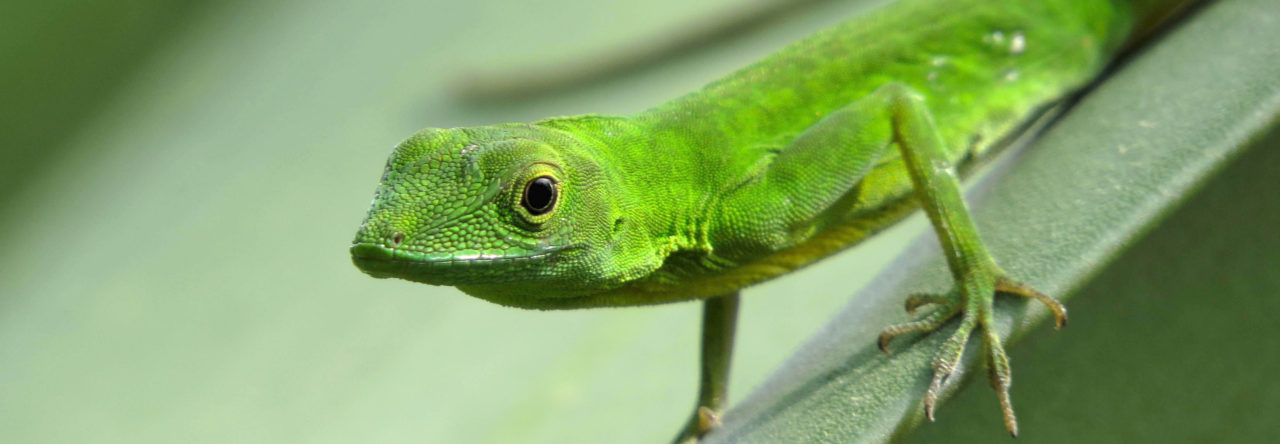Jessica Stapley writes:
I am a Marie Curie Postdoctoral fellow co-hosted by the University of Sheffield and the Smithsonian Tropical Research Institute (STRI) in Panama. I have just started a new project aimed at identifying loci underlying Anolis dewlap colour pattern.
Understanding the evolution and maintenance of phenotypic variation is a major goal in evolutionary biology. Addressing this goal ultimately requires linking molecular genetic variation to phenotypic variation, but identifying the genes responsible for important traits has been a major challenge in non-model organisms. Recent advances in DNA sequencing technology however, have revolutionized the development of genomic resources and paved the way for major advances in linking phenotype and genotype in non-model organisms.
Pigmentation systems are fascinating and beneficial phenotypes to consider for gene mapping, they underlie an enormous diversity of phenotypic variation, with varied functional roles. In Anolis apleotphallus I have characterized a dewlap color pattern polymorphism that provides a useful study system to begin linking phenotypes to genotypes. Males have either a solid orange dewlap (solid) or a white dewlap with a basal orange spot (basal). The distribution of morphs changes across the species range in central Panama. To the Southeast the solid morph occurs exclusively, to the Northwest the basal morph occurs exclusively, and in between both morphs occur at roughly equal frequencies. There is no evidence of restricted gene flow between dewlap morphs based on microsatellite data, suggesting that this represents a classic polymorphism within a single species (Editor’s note: see recent paper in Journal of Heredity which reports the results just summarized).
To identify potential candidate genes or genomic regions underlying this color pattern polymorphism I will adopt an integrated approach; combining quantitative trait loci (QTL) mapping, population genomics and association scans. I will use RAD-tag sequencing to sequence and genotype thousands of SNPs across the genome in wild caught lizards and within a captive bred population. Using a multi-locus genome scan on wild caught lizards I will look for outlier loci and perform an association scan between dewlap morphs to identify regions of the genome under divergent selection and/or regions associated with variation in dewlap color pattern. In captivity I will set up a cross between the two dewlap color pattern morphs and breed three generations of lizards. Using the same RAD-tags I will genotype these individuals to create a genetic linkage map and perform QTL analysis for dewlap color pattern. This integrated approach can greatly improve our ability to identify loci underlying phenotypic variation and can help us understand how selection has acted on these loci in natural populations.
- Evolution in Real Time on Lizard Island - March 23, 2025
- Spider Snags Adult Anolis osa - March 22, 2025
- An Homage to the Green Anoles of New Orleans - March 21, 2025



Rich Glor
Sounds very cool. My lab is doing similar work with Anolis distichus from Hispaniola. This species has dewlaps that range from pale yellow to deep red. We got our first generation of F1 crosses between orange and yellow dewlapped populations last year and have another breeding experiment running this spring. Its crazy to think that anole biologists may not be that far from identifying the genes and regulatory/developmental mechanisms underlying dewlap color variation! It will be especially cool to figure out if the same mechanisms are involved in different species.
FCrayola
I agree it’s cool to find the genetic architecture underlying such a tremendously varying phenotype. However, the jury is still out on what anoles use the dewlap for. Has sexual selection ever been demonstrated? Is the variation pure local adaptation? Until we have these issues sorted out, this reminds me of the contest Crayola puts out every few years to name the color of a new crayon.
That said, finding these genes is probably worthy of a Nature paper, but no one will know how they contribute to the actual drawing (=anole evolution). But, I suppose finding them will let other researchers conduct more rigorous studies to elucidate the evolutionary processes driving dewlap ‘disparification.’